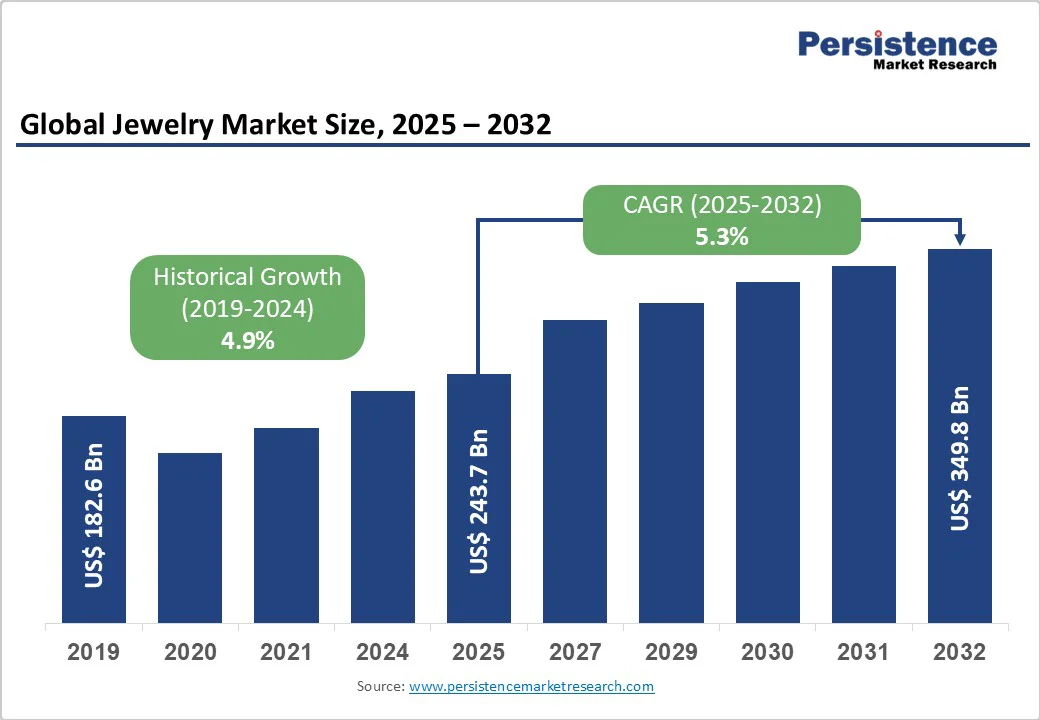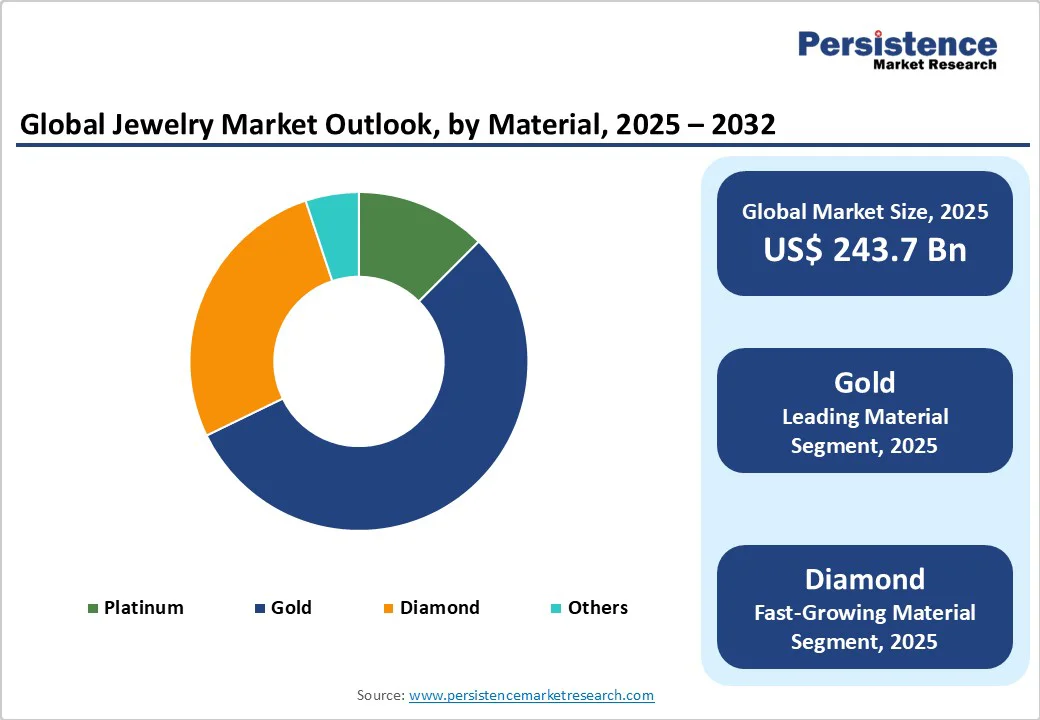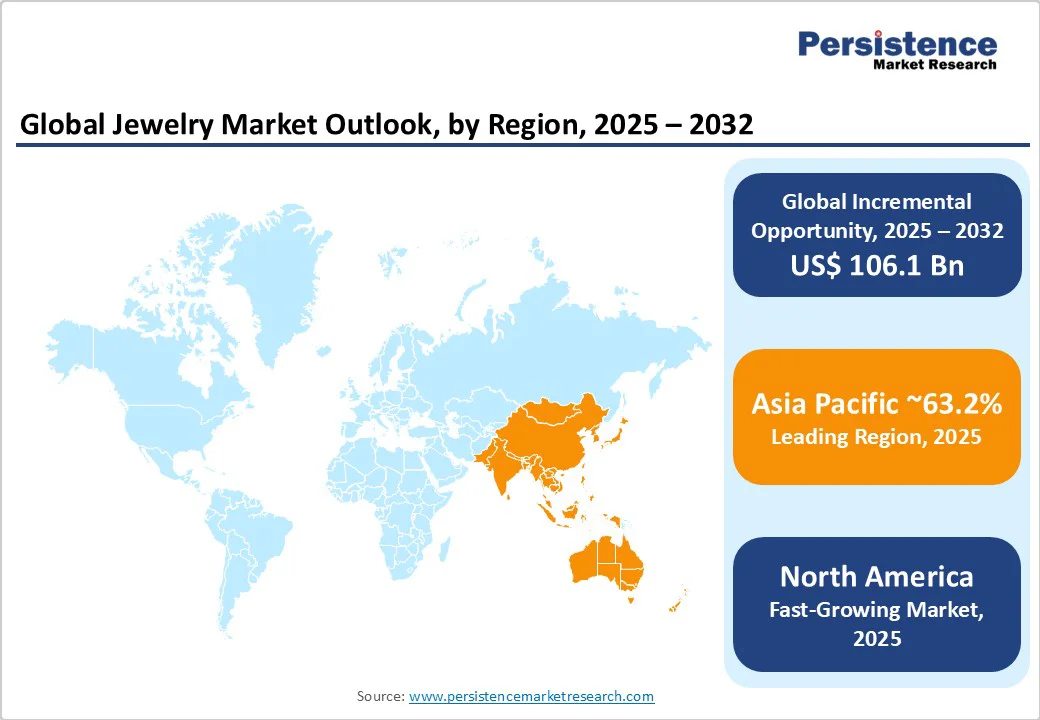ID: PMRREP35671| 187 Pages | 3 Oct 2025 | Format: PDF, Excel, PPT* | Consumer Goods

The global jewelry market size is expected to be valued at US$243.7 billion in 2025 and is projected to reach US$349.8 billion in 2032, growing at a CAGR of 5.3% during the forecast period of 2025 -2032, driven by the rising demand for luxury and personalized pieces. This further encourages brands to offer custom designs, engraved items, and ethically sourced materials.
| Key Insights | Details |
|---|---|
| Jewelry Market Size (2025E) | US$243.7 Bn |
| Market Value Forecast (2032F) | US$349.8 Bn |
| Projected Growth (CAGR 2025 to 2032) | 5.3% |
| Historical Market Growth (CAGR 2019 to 2024) | 4.9% |

The jewelry market is experiencing a rapid shift toward luxury and personalized pieces, boosted by evolving consumer preferences. Modern consumers, particularly Gen Z and millennials, are seeking jewelry that reflects their individuality and values. This trend is evident in the high demand for custom-made items, including engraved pieces and those crafted from recycled materials.
Brands such as By Pariah, which utilizes 100% recycled materials, and Accessories of Old, delivering vintage charm necklaces, are gaining popularity by catering to these consumer desires for unique and sustainable jewelry. The rise of ‘small luxuries’ has also made high-quality, personalized jewelry more accessible. Consumers are now investing in affordable luxury items such as customized rings and necklaces, which provide a sense of exclusivity without the high price tag.
The entry of new designers into the market is diversifying products and fueling growth. These emerging designers often bring fresh perspectives, unique designs, and a focus on sustainability, appealing to a broad consumer base. For instance, brands such as Loveness Lee and Cece Jewelry are gaining momentum by combining craftsmanship with personal storytelling, providing pieces that resonate emotionally with consumers.
The rise of digital platforms has further enabled these new designers to reach global audiences, bypassing traditional retail limitations. Social media and online marketplaces enable designers to showcase their work, engage directly with customers, and cultivate brand loyalty. This accessibility has lowered entry barriers, encouraging more designers to enter the market and contribute to its expansion.
The market faces significant challenges due to the volatility in the prices of raw materials, including gold, silver, and gemstones. For example, gold prices have reached record highs, leading to increased production costs for jewelers. Additionally, U.S. tariffs on imported jewelry have increased, affecting pricing and sourcing strategies for brands that rely on overseas manufacturing.
These fluctuations tend to disrupt production schedules and impact profit margins, mainly for small and medium-sized enterprises. To mitigate these challenges, some jewelers are focusing on sustainability and long-term customer value, adjusting their strategies to navigate the changing economic landscape.
Jewelry retailers are vulnerable to theft and counterfeiting, which pose risks to both their inventory and brand reputation. The National Retail Federation's latest security survey indicates that jewelry stores experience theft rates 60% higher than the average retail establishment.
This risk stems from factors such as the high value-to-size ratio of merchandise, the portable nature of jewelry items, and the superior resale market for stolen goods. Also, counterfeit jewelry, often of inferior quality and made with dangerous or toxic materials, undermines consumer trust.
Developments in 3D printing and smart jewelry are revolutionizing the market by improving customization and functionality. 3D printing enables the creation of intricate designs with reduced material waste and short production times, allowing for personalized and affordable pieces.
For instance, IIT Indore's development of a cost-effective metal 3D printing technology, Micro-Plasma Metal Additive Manufacturing (MP-MAM), has the potential to make high-quality metal components more accessible, impacting sectors such as jewelry manufacturing. The rise of smart jewelry also integrates technology with traditional adornments, providing features such as fitness tracking and health monitoring.
Collaborations between renowned jewelry designers and leading fashion brands are expanding market reach and introducing fresh design perspectives. These partnerships often blend the designer's unique aesthetic with the fashion brand's broad consumer base, resulting in exclusive collections that attract diverse audiences.
For example, H&M's collaboration with Mexican designer Lorena Saravia incorporated elements of traditional Mexican crafts into a 29-piece collection, featuring accessories that showcase artisanal techniques. Such collaborations not only enhance the visibility of jewelry designers but also enable fashion brands to diversify their product lines.
Rings are predicted to account for approximately 34.8% share in 2025, as these hold a special place in jewelry due to their symbolic significance and versatility. They are often associated with important life events such as engagements, weddings, and personal milestones, making them meaningful gifts and personal adornments.
Additionally, rings offer a unique opportunity for personalization. Designers can incorporate various gemstones, engravings, and metal choices to create custom pieces that reflect individual style and sentiment.
Necklaces are expected to record a CAGR of around 5.9% through 2032, driven by high demand for personalized and statement pieces. Customized necklaces, such as those featuring initials, birthstones, or meaningful engravings, are cherished for their sentimental value.
They serve as unique expressions of identity and are often given as thoughtful gifts, thereby strengthening the emotional connection between the wearer and the gift. The versatility of necklaces also contributes to their rising popularity. They can be layered to create a personalized look, allowing individuals to express their style and creativity.
Gold is poised to hold a share of about 55.3% in 2025, spurred by its unique combination of physical and aesthetic properties. Its high metallic luster reflects nearly all light, giving it a brilliant shine that is both timeless and universally appealing.
Additionally, gold is chemically inert, and hence it resists tarnish and corrosion, ensuring that jewelry pieces maintain their appearance over time. The malleability of gold enables artisans to craft intricate designs, ranging from delicate filigree to bold statement pieces.
Diamond will likely rise at a CAGR of approximately 5.4% in the foreseeable future due to its deep-rooted cultural significance and evolving market trends. Traditionally, diamonds symbolize love, commitment, and milestones, making them a popular choice for engagements, weddings, and special occasions.
Recent shifts in consumer preferences have also influenced diamond demand. There is a surging interest in sustainable and ethically sourced diamonds, with consumers opting for lab-grown diamonds that deliver an eco-friendly alternative to mined stones.
Offline retail stores are projected to account for nearly 85.1% share in 2025, fueled by the tactile experience they provide. Customers can physically examine the quality, craftsmanship, and authenticity of pieces, which is essential when purchasing high-value items such as gold or diamond jewelry.
This hands-on approach helps in building trust and confidence in the product. Additionally, local jewelry stores often offer personalized services, including custom designs, resizing, and on-site repairs. This level of customer care is challenging to replicate online.
Online retail stores are expected to register a CAGR of around 8.0% through 2032 due to the convenience and variety they provide. Consumers can browse a wide range of designs, compare prices, and read reviews from the comfort of their homes.
This accessibility appeals to busy individuals seeking efficiency in their shopping experience. Technological developments have also improved online jewelry shopping. Features such as virtual try-ons, detailed product images, and secure payment options provide a more interactive and trustworthy online shopping environment.

In 2025, the Asia Pacific is expected to account for approximately 63.2% of the global share, driven by increasing demand from India and China, where gold is a prominent feature of weddings and festivals. Gold jewelry alone makes up nearly 70% of the market, but young buyers are also showing interest in diamonds, both mined and lab-grown, as well as sustainable gemstones. The way jewelry is bought is changing at a fast pace.
Online platforms, virtual try-ons, and customization tools are gaining traction, particularly in Tier 2 and Tier 3 cities. In India, brands such as Tanishq are expanding their e-commerce presence, while in China, jewelers are integrating digital platforms with flagship stores to attract young customers.
Younger generations also prefer lightweight and minimalist jewelry that suits everyday use rather than only heavy ceremonial pieces. This shift is pushing brands to highlight provenance and eco-friendly sourcing in their collections.
North America is estimated to hold a nearly 23.7% share in 2025, driven by the rising popularity of lab-grown diamonds. Surveys show that over half of U.S. engagement rings in 2024 featured lab-grown stones, primarily because they are more affordable and marketed as an ethical alternative.
This trend is transforming how retailers position natural diamonds. Sustainability and ethics are powerful selling points. Brands such as Brilliant Earth are therefore expanding showrooms while promoting traceable supply chains and recycled metals.
Digital tools play a significant role in the buying journey. Virtual try-ons, home previews, and custom design platforms are helping consumers shop confidently online. Companies such as With Clarity are using these models successfully to compete with traditional stores.
Consumer behavior is also shifting. More buyers, especially women, purchase jewelry for themselves rather than waiting for gifts to be given to them. Jewelry is increasingly viewed as an everyday fashion accessory, rather than just a special occasion purchase.
In Europe, sustainability has become the most prominent theme in the jewelry industry. Pandora now makes all of its pieces with 100% recycled silver and gold and runs its factories on renewable energy. This focus on recycling and circularity is turning into a new standard across the region. Lab-grown diamonds are gaining traction. Awareness is generally high in Italy, where more than 80% of consumers are familiar with them.
Brands such as Courbet in France and Veynou in Germany focus entirely on lab-grown diamonds and recycled gold. It demonstrates how small-scale players are leveraging ethics and technology as their defining characteristics. Online jewelry sales are further rising. Virtual try-ons and custom design tools are making consumers more comfortable buying demi-fine jewelry digitally. This trend is helping small ethical brands reach customers across borders without requiring large flagship stores.

The global jewelry market is highly fragmented, with global luxury giants such as LVMH and Richemont competing against regional players of similar caliber, including Titan’s Tanishq in India and Damas in the Middle East.
While luxury houses dominate branding and global visibility, regional brands are expanding through powerful retail networks and cultural positioning to capture everyday jewelry buyers. Designers who once relied solely on showrooms, such as Sabyasachi, are now entering e-commerce through luxury platforms.
Jewelry brands focus on innovation in design and materials, cost leadership through lab-grown diamonds and streamlined supply chains, and expansion via omnichannel retail. Market leaders differentiate with heritage branding, craftsmanship, and trust. Emerging trends include direct-to-consumer models, digital-first launches, sustainable sourcing, and resale platforms that appeal to young buyers.
The jewelry market is projected to reach US$243.7 Bn in 2025.
Rising demand for luxury jewelry and surging popularity of lab-grown diamonds are the key market drivers.
The jewelry market is poised to witness a CAGR of 5.3% from 2025 to 2032.
3D printing for intricate designs and the rise of wearable tech in jewelry are the key market opportunities.
Cartier, Titan Company Limited, and Damas Jewelry are the key market players.
| Report Attribute | Details |
|---|---|
| Historical Data/Actuals | 2019 - 2024 |
| Forecast Period | 2025 - 2032 |
| Market Analysis | Value: US$ Bn |
| Geographical Coverage |
|
| Segmental Coverage |
|
| Competitive Analysis |
|
| Report Highlights |
|
By Product Type
By Material
By Distribution Channel
By End-user
By Region
Delivery Timelines
For more information on this report and its delivery timelines please get in touch with our sales team.
About Author